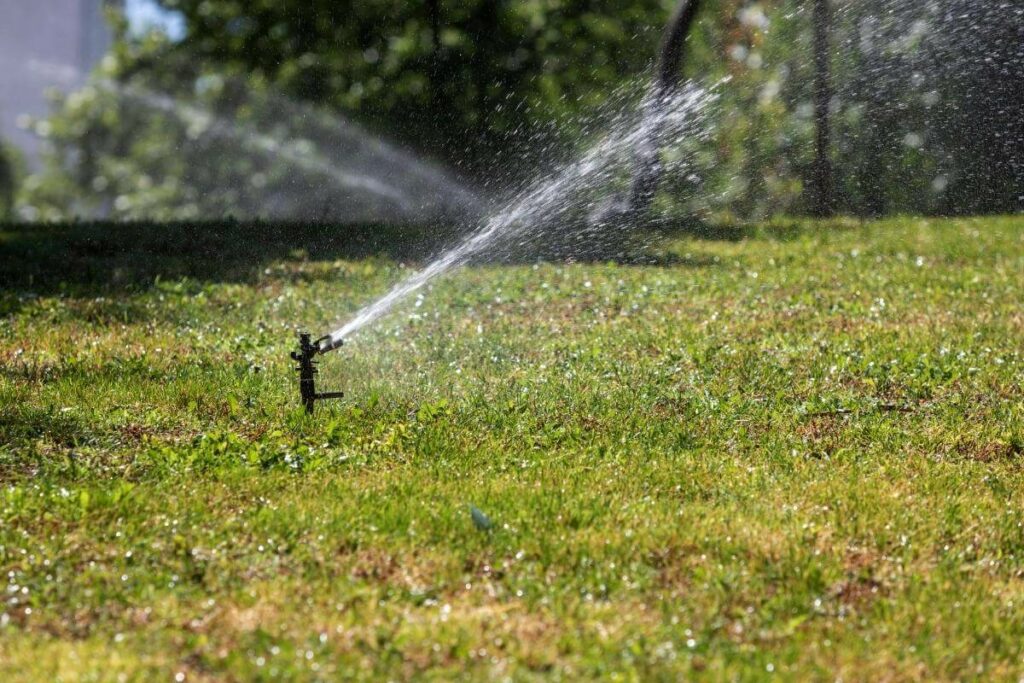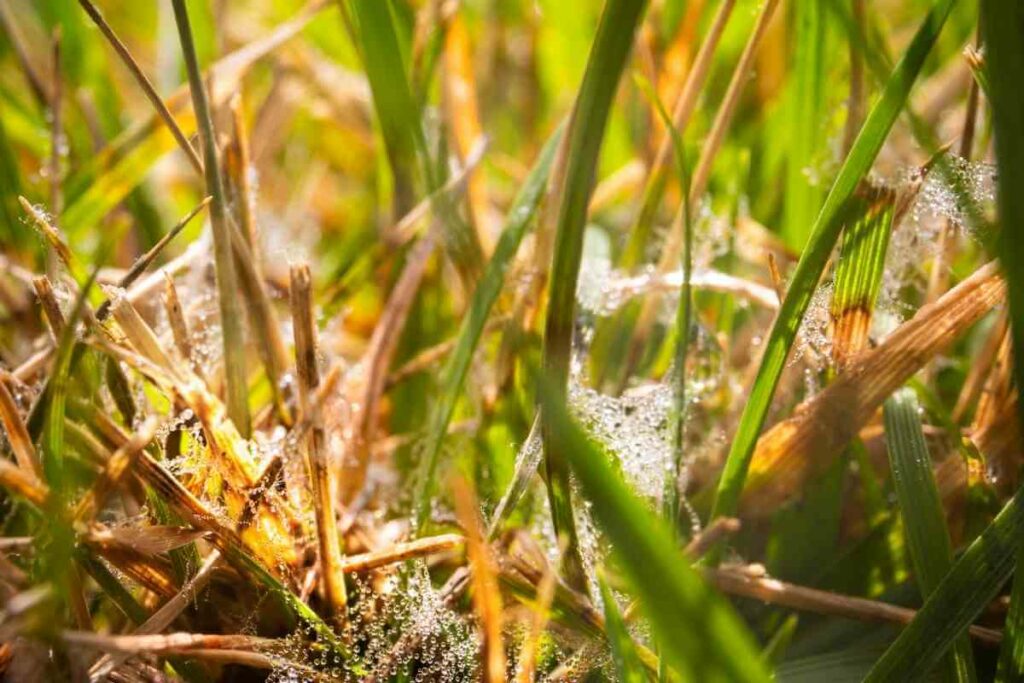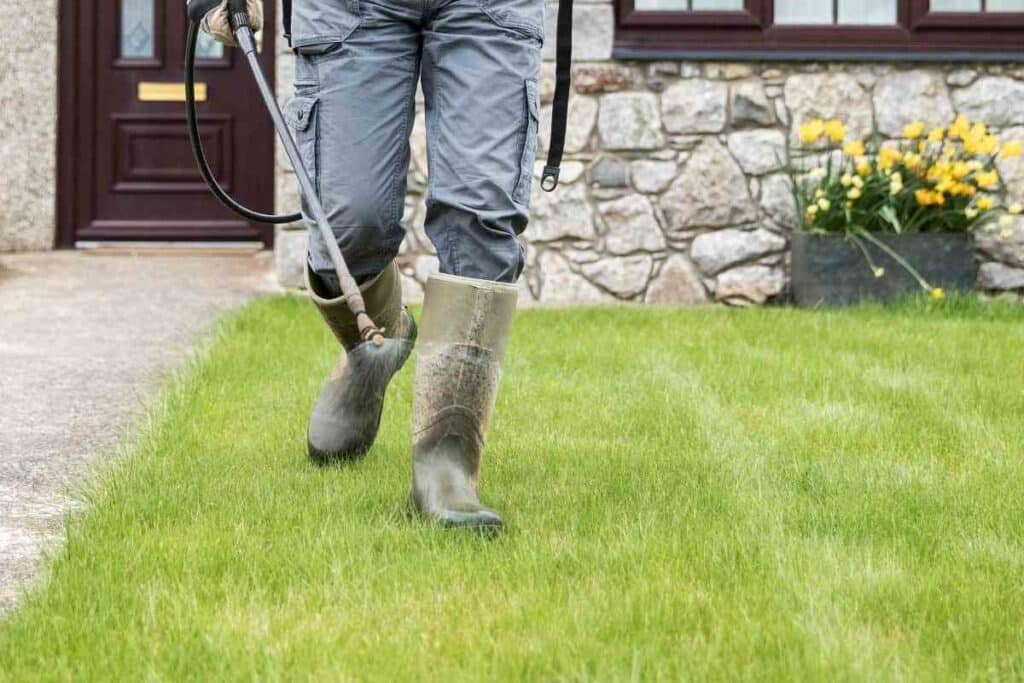Everybody wants a healthy lawn that is lush, green, and healthy.
To achieve this, you have to put in the effort to nurture the lawn and keep working on it at all times.
Sometimes, however, despite the work you put in, yellow stripes still appear.
Various factors cause the yellow stripes.
These include:
- overfertilization
- too much water
- underwatering
- lawn diseases
- pet urine
- nutritional deficiency
- and damage by a mower
Thus, yellow stripes could be a result of one or a combination of these factors.
What to Expect? By the end of this article, you will be able to gauge why your lawn is discoloring. You will also have ideas on how to rectify that situation.
Why Your Lawn Has Yellow Stripes
As we have established, there are various reasons why your lawn is forming yellow stripes.
The common misconception is that a yellow lawn results from water deficiency.
However, that is not always true. There are other causes, and they are discussed in detail below.
Overfertilization
Normally, applying fertilizer to your lawn is beneficial as it leads to green, lush, and healthy grass.
However, applying too much fertilizer can be detrimental to the well-being of your grass.

Nitrogen is the first number in fertilizers, so a high quantity of fertilizer translates to high levels of nitrogen salts in the soil.
This changes the pH of the grass, making it acidic. The acidity then burns the grass, yellowing it. This phenomenon is called leaf scorch.
Synthetic fertilizers are the type that is most likely to cause leaf scorch.
Fertilizer Misses
Sometimes when applying fertilizer, it is possible to miss some spots.
These spots then become deficient in the nutrients that are provided by the fertilizer.
The deficiency then causes these parts to turn yellow while the rest of the grass thrives.
Therefore, if you notice some parts of the lawn yellowing soon after applying fertilizer, it is because you missed those spots.
Overwatering and Underwatering
When you use more water than is required, the lawn becomes waterlogged.
A soggy lawn causes the grassroots to become shallow and, as a result, unable to reach the nutrients, water, and food in the soil.

This causes poor development of the glass, which is marked by yellow streaks.
Underwatering is also a cause of the discoloration of your lawn. During summer, when water is deficient, its rates go up.
Due to the expenses, people strive to conserve water and use it sparingly. Therefore, the water used for watering the lawn is reduced.
A water-deprived lawn cannot carry out the processes it needs to remain healthy. Therefore, the grass becomes yellow.
Lack Of Enough Nutrients
One of the reasons your lawn may develop yellow stripes is when it is not receiving enough nutrients.
This could be because the soil is not enriched enough, the lawn is waterlogged, or you do not apply enough fertilizer.
Nutrients such as nitrogen and iron are especially essential, and the lack of them causes grass to yellow up.
Lawn Diseases
Just like other plants, grass is prone to disease.

Usually, diseases are caused by pests and insects. Most lawn diseases are fungal and are instigated by a damp environment.
Some of the common lawn diseases include:
- Fusarium
- snow mold
- fairy rings
- and smut
Overwatering your lawn reduces its immune against diseases and creates an environment for fungal infestation.
These diseases manifest by forming yellow patches on the grass.
Damage By a Mower
Using a lawn mower the wrong way could cause major damage to your grass.
When yellow lines form soon after mowing your lawn, then you should change your mowing technique.

One of the reasons why your mower may be destructive is dull blades.
They cause stress on the grass, causing it to discolor. Similarly, using a heavy mower on already-stressed grass causes it to weaken.
Additionally – Cutting off too much grass and making it too short deprives it of enough moisture, causing it to discolor.
If the ends of your grass are discolored, but the rest of the stalks are green, then the cause of the discoloration is a mower.
Dog Urine
Dogs have the habit of peeing anywhere.

Sometimes they may pick a spot on your lawn where they will be relieving themselves. Dog pee contains a high concentration of nitrogen.
Excess nitrogen burns grass, causing it to have yellow patches.
How Do I Get Rid of Yellow Stripes on My Lawn?
Knowing the reason behind the discoloration of your lawn is the first step to solving the problem.
Then you can take action to restore your lawn depending on the problem.
For instance, if the issue is underwatering, you can start watering your lawn sufficiently to correct the problem.
Here are some of the ways to make your lawn green and lush again.
Conduct a Soil Test
Conducting a soil test will enable you to determine what nutrients are missing in the soil.
You don’t necessarily have to get a professional to do it for you- there are at-home test kits that are straightforward to use.
They give dependable results such that you can easily course-correct and provide your lawn with the nutrient it is missing.
Treat the Diseases
Once you establish that your lawn is infested by disease, resolve to treat it.
Apply fungicides to get rid of the larvae in the soil and kill the fungus causing the diseases. With time, the grass will start turning green again.
Correct Application of Fertilizers
To avoid overfertilization, follow the manufacturer’s instructions on the correct quantity and mode of application.

If it happens that you overapply, flush the spot with water to tone down the effect of excessive nitrogen.
Organic fertilizers are safer to use than synthetic ones as the former is slow-releasing, so the chances of burning your grass are low.
Also, see to it that you apply the fertilizer precisely to avoid missing some parts.
Watering the Lawn Correctly
The goal is to avoid overwatering or underwatering your lawn.
One thing to consider when watering your lawn is the weather.
For Instance – You do not have to keep watering the lawn during the rainy season, as the rain keeps the soil sufficiently moist.
During summer, when there is drought, you may want to be more diligent with watering your lawn so that it does not dry up.
Even so, avoid watering under direct sunlight as the water will evaporate and leave the grass dry. The best time to water your lawn is in the morning and evening.
Additionally, if you are using a sprinkler to water your lawn, ensure that it touches every part of the lawn.
Leaving out some parts will lead to them drying up and discoloring. Essentially, you ought to water your lawn when the top two inches of the topsoil are dry.
Proper Use of A Lawn Mower
Using your lawn mower correctly will protect your grass from discoloration:
- First off, refrain from mowing too often. It is important to give the grass time to grow back after you mow it. Mowing too frequently will weaken the grass and cause it to die off.
- Secondly, do not cut the grass too low. It is advisable to keep it above 3 inches high for optimum health.
- Also, it is best to mow when the grass is dry- so do not mow it immediately after watering it.
- The blade should be sharp to avoid stressing the grass. If you notice that the blade is becoming blunt, sharpen it or replace it promptly.
If you find that mowing and maintaining your lawn is challenging for you, consider hiring a professional lawn carer.
They will apply their skill and knowledge to ensure your lawn is in the best condition.
Supervise Your Pets
If you own a dog, train it to pee elsewhere to avoid ruining your lawn.
If it urinates on the lawn, then apply urine neutralizer immediately. The neutralizer slows down nitrogen in the urine from burning the grass.
Final Words
The joy of having a beautiful, green, and lush lawn is unmatched.
However, yellow stripes on your lawn can interfere with the aesthetics of it all.
Therefore, it is important to know what causes the stripes and how to rectify that.
Some of the causes, as discussed in the article, include overwatering, underwatering, overfertilization, and wrong use of the lawn mower.
